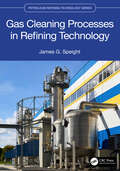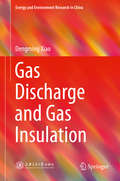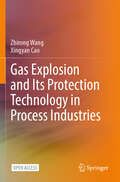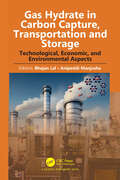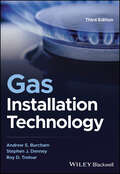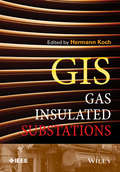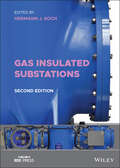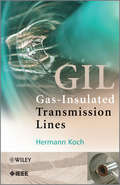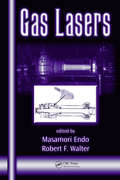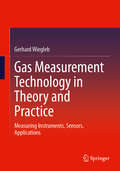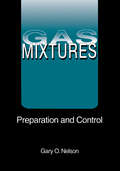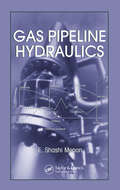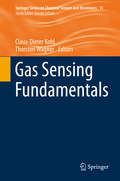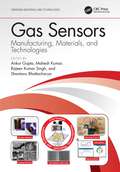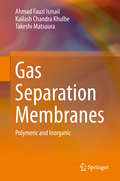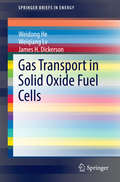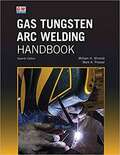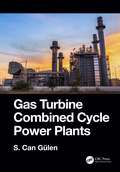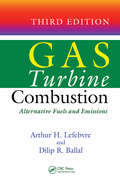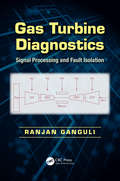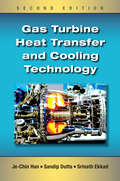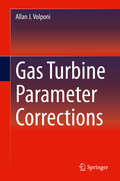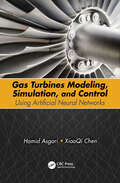- Table View
- List View
Gas Cleaning Processes in Refining Technology (Petroleum Refining Technology Series)
by James G. SpeightThis book focuses on the various refinery processes that are used for gas cleaning operations. By understanding the use of gas cleaning processes, this book will satisfy the needs of engineers and scientists at all levels from academia to the refinery and help them understand the initial various processes. This accessible guide is written for managers, professionals, and technicians as well as graduate students transitioning into the refining industry.Key Features: Describes gas streams produced in a crude oil refinery and from non-refinery feedstocks. Covers gas condensate, gas from biomass, waste and landfill waste, and details categorization by types of contaminants and by removal method. Provides an extensive glossary. Discusses the future of gas cleaning operations and the evolution of the industry. This series of eight books is designed to present descriptions of (1) the development of technologies for a variety of feedstocks (including the viscous feedstocks which are often referred to as heavy feedstocks) utilizing advanced pre-treatment processing and hydrotreating, (2) an analysis of the catalyst deactivation mechanism for developing optimum technologies for processing feedstocks with low reactivity, (3) the development of advanced technologies applicable to the viscous feedstocks, (4) the development of advanced hydrocracking processes for heavy feedstock upgrading, (5) the development of innovative upgrading processes for the viscous feedstocks, and (6) the role of biomass in the future refinery. Furthermore, each book is a stand-alone volume that will bring the reader further up to date and adds more data as well as processing options that may be the processes of the evolving twenty-first century. As the eighth book in the series, this book will focus on the various refinery processes that are used for gas cleaning operations.The target audience includes engineers, scientists, and students who want an update on crude oil processing and the direction of the industry in the next 50 years. Such personnel include (1) professionals in the refining industry, (2) technicians in the refining industry, (3) industry management personnel who need to understand the various processes and the role of these process in producing the desired feedstocks for further processing and the use of solvents to produce saleable products, and (4) the academic staff and graduate students who are moving into the refining industry. Any non-technical readers, with help from the extensive glossary, will also benefit from the series.
Gas Discharge and Gas Insulation
by Dengming XiaoThis book presents a comprehensive overview of research on environmentally friendly insulating gases, in response to the urgent calls for developing alternatives to SF6 due to the increasing awareness of the threat it poses as a greenhouse gas. It covers gas dielectrics, SF6 and its mixtures, and potential alternative gases, providing fundamental information on gas discharge and gas insulation and especially focusing on the development of new environmentally friendly insulating gases over the last decade. The book begins by describing the insulating and arcing characteristics of SF6, followed by an introduction to the gas dielectrics performance of SF6 gas mixtures with buffer gases. The latest findings on new environmentally friendly insulating gases are described in detail, and suggestions for practical application are also provided. Graduate students and teachers involved in high-voltage and insulation engineering can use the book as teaching material. Researchers working in plasma science, laser action and related applied physics fields can also benefit from the book's analytical approach and detailed data; engineers from the fields of electric power operation systems and electrical manufacturing will find it a valuable reference work for solving practical problems.
Gas Explosion and Its Protection Technology in Process Industries
by Zhirong Wang Xingyan CaoThis open access book first introduces the explosive characteristics of combustible gas in the process industrial device, and then introduces the influence law of structural effect on gas explosion characteristics and deflagration to detonation process, and finally introduces the suppression mechanism and protection technology of gas explosion. This book takes the process industrial gas explosion characteristics and its protection as the research object, and discusses the gas explosion characteristics and its protection theory in details. This book can be used as the undergraduate and graduate textbook of safety engineering and related engineering majors in universities, and also as a reference for scientific research staff in safety science and engineering and related disciplines, and also for the reference of safety technology and management personnels.
Gas Hydrate in Carbon Capture, Transportation and Storage: Technological, Economic, and Environmental Aspects
by Bhajan Lal Anipeddi ManjushaThis book offers a deep insight into gas hydrate-based carbon capture, transportation, and storage technology as a solution to decarbonization. The key aspects of carbon capture & storage technologies are discussed together with their advantages and status of development and commercialization. The authors delve into intricacies of gas hydrate reactor design, provide a review on the Techno-Economic Aspects (TEA), expound critical safety considerations and elucidate upon the regulatory mandates shaping the landscape of decarbonization initiatives.Gas Hydrate in Carbon Capture, Transportation and Storage: Technological, Economic, and Environmental Aspects is an essential resource for all academicians, researchers, flow assurance engineers, industry professionals and students working in this field.
Gas Installation Technology
by Andrew S. Burcham Stephen J. Denney Roy D. TreloarUnderstand the core competencies of gas installation with this accessible textbook Gas operatives in the UK must be Gas Safe registered, suitably qualified and assessed as competent in the aspect of gas work that they wish to undertake. Qualification is gained by means of an industry recognised Managed Learning Programme or a gas aligned National Vocational Qualification (NVQ/SNVQ). Periodic renewal thereafter is by means of the National Accredited Certification Scheme (ACS). Gas Installation Technology is the definitive textbook for students enrolled in any of these courses. Now fully updated to reflect new standards and the most up to date best practices, it remains the indispensable reference for anyone working in the gas industry. Readers of the third edition of Gas Installation Technology will find: Coverage of commercial, domestic, and LPG installations New or updated material on 'net zero' targets, climate change, and other aspects of the gas industry's future Notes and examples within each chapter to facilitate learning Gas Installation Technology is ideal for students in gas installation or plumbing courses, as well as for professional gas installers renewing their certification. Coverage of commercial, domestic, and LPG installations New or updated material on 'net zero' targets, climate change, and other aspects of the gas industry's future Notes and examples within each chapter to facilitate learning
Gas Insulated Substations
by Hermann J. KochComprehensive reference covering all aspects of gas insulated substations including basic principles, technology, use & application, design, specification, testing and ownership issuesThis book provides an overview on the particular development steps of gas insulated high-voltage switchgear, and is based on the information given with the editor's tutorial. The theory is kept low only as much as it is needed to understand gas insulated technology, with the main focus of the book being on delivering practical application knowledge. It discusses some introductory and advanced aspects in the meaning of applications.The start of the book presents the theory of Gas Insulated Technology, and outlines reliability, design, safety, grounding and bonding, and factors for choosing GIS. The third chapter presents the technology, covering the following in detail: manufacturing, specification, instrument transformers, Gas Insulated Bus, and the assembly process. Next, the book goes into control and monitoring, which covers local control cabinet, bay controller, control schemes, and digital communication. Testing is explained in the middle of the book before installation and energization. Importantly, operation and maintenance is discussed. This chapter includes information on repair, extensions, retrofit or upgrade, and overloading. Finally applications are covered along with concepts of layout, typical layouts, mixed technology substations, and then other topics such as life cycle assessment, environmental impact, and project management. A one-stop, complete reference text on gas insulated substations (GIS), large-capacity and long-distance electricity transmission, which are of increasing importance in the power industry todayDetails advanced and basic material, accessible for both existing GIS users and those planning to adopt the technologyDiscusses both the practical and theoretical aspects of GISWritten by acknowledged GIS experts who have been involved in the development of the technology from the start
Gas Insulated Substations (IEEE Press)
by Hermann J. KochGAS INSULATED SUBSTATIONS An essential reference guide to gas-insulated substations The second edition of Gas Insulated Substations (GIS) is an all-inclusive reference guide to gas insulated substations (GIS) and its advanced technologies. Updated to the latest technical developments and applications, the guide covers basic physics of gas insulated systems, SF6 insulating gas and its alternatives, safety aspects and factors to choose GIS. GIS technology, its modular structure, control and monitoring systems, testing, installation rules and guidelines for operation, specification, and maintenance. Detailed information on various types for GIS, with 14 reference project explanations and three extensive case studies give information for the best solutions of practical applications. Special solutions using mobile substations concepts, mixed technology switchgear (MTS) with air and gas insulated technology, underground substations, and the use of special GIS substation buildings e.g., shopping centers, parking lots, city parks, business complexes’ or subway stations are explained. Future developments of GIS technology are shown for the next steps in alternatives to SF6, low power instrument transformers, and digitalization of substations. A new chapter explains advanced technologies applied to GIS projects which cover the following; environmental issues for the substation permission process, insulation coordination studies for the network requirements including very fast transients, project scope development, risk-based asset management, health and safety impact, electromagnetic fields, SF6 decomposition byproducts and condition assessment. Disruptive development steps in gas insulated substations technologies are also covered in this second edition. Vacuum breaking and switching technology for rated voltages of up to 500 kV is explained in detail with its physical background. Principle function and possible implementation of low power instrument transformers (LPIT) are explained and examples of applications are given. The principles of digital twin for gas insulated substations (GIS) and gas insulated transmission lines (GIL) are explained in theory and project applications show the practical use and advantage. The wide and fast-growing technical field of offshore GIS applications for AC and DC is explained on many examples and gives information on special requirements when getting offshore. Theoretical requirements on DC gas insulated systems, methods of testing, prototype installation tests, modular design features, and advantages in applications are given. Finally, impact and advantages of digital substations using GIS are explained. Key features: Written by leading GIS experts involved in development and project applications Discusses practical and theoretical aspects Detailed material of GIS for new and experienced GIS users, and project planners Invaluable guide to practicing electrical, mechanical and civil engineers as well as third- and fourth-year electric power engineering students
Gas Insulated Transmission Lines (GIL)
by Hermann KochGas-insulated transmission lines (GIL) is an established high voltage technology used when environmental or structural considerations restrict the use of overhead transmission lines. With an overview on the technical, economical and environmental impact and power system implications of GIL, this guide provides a complete understanding of its physical design, features and advantages. The author illustrates how to evaluate when GIL would be the best solution during the planning sequence and how to apply GIL in the electricity power network.Other key features include:operation and maintenance requirements with information on repair processes, duration, and different monitoring systems enabling the achievement of reliable and safe operation;a wide variety of realized applications from across the world over the past 35 years, illustrating typical fields of application through descriptions of real projects that the author has worked on; andfuture application possibilities in a smart transmission network, used for solving power transmission problems.This is an essential reference for engineers involved in planning and executing bulk power transmission projects overground, in tunnels or buried. It offers a concise summary of all areas of the subject and is the perfect aid for utility power engineers, consulting engineers and manufacturers worldwide.
Gas Lasers (Optical Science and Engineering)
by Masamori Endo and Robert F. WalterLasers with a gaseous active medium offer high flexibility, wide tunability, and advantages in cost, beam quality, and power scalability. Gas lasers have tended to become overshadowed by the recent popularity and proliferation of semiconductor lasers. As a result of this shift in focus, details on modern developments in gas lasers are difficult to find. In addition, different types of gas lasers have unique properties that are not well-described in other references. Collecting expert contributions from authorities dealing with specific types of lasers, Gas Lasers examines the fundamentals, current research, and applications of this important class of laser.It is important to understand all types of lasers, from solid-state to gaseous, before making a decision for any application. This book fills in the gaps by discussing the definition and properties of gaseous media along with its fluid dynamics, electric excitation circuits, and optical resonators. From this foundation, the discussion launches into the basic physics, characteristics, applications, and current research efforts for specific types of gas lasers: CO lasers, CO2 lasers, HF/DF lasers, excimer lasers, iodine lasers, and metal vapor lasers. The final chapter discusses miscellaneous lasers not covered in the previous chapters.Collecting hard-to-find material into a single, convenient source, Gas Lasers offers an encyclopedic survey that helps you approach new applications with a more complete inventory of laser options.
Gas Measurement Technology in Theory and Practice: Measuring Instruments, Sensors, Applications
by Gerhard WieglebThe book describes the physical properties of gases and describes the different measuring methods and sensor principles for the analysis of gas mixtures. The use of gas sensors in different applications is shown by means of practical examples. These applications of the metrological detection of gases originate from many fields of engineering, in particular energy technology, food technology, process engineering, biotechnology, safety engineering, medical technology and environmental technology.This book is a translation of the original German 1st edition Gasmesstechnik in Theorie und Praxis by Gerhard Wiegleb, published by Springer Fachmedien Wiesbaden GmbH, part of Springer Nature in 2017. The translation was done with the help of artificial intelligence (machine translation by the service DeepL.com). A subsequent human revision was done primarily in terms of content, so that the book will read stylistically differently from a conventional translation. Springer Nature works continuously to further the development of tools for the production of books and on the related technologies to support the authors.
Gas Mixtures: Preparation and Control
by Gary NelsonGas Mixtures provides practical suggestions and calculations for producing multicomponent test gas atmospheres. General topics addressed include sorbent evaluation, methods development, dosimeter testing, instrument calibration, atmospheric simulation, and gas analysis. Learn the tricks of the trade for producing gas mixtures over a wide range of concentrations using even the most difficult-to-handle materials. Gas Mixtures is a must for industrial hygienists, air pollution control specialists, analytical chemists, and others working in such areas as health and safety, air pollution, air cleaning, and respirator and carbon research.
Gas Pipeline Hydraulics
by E. Shashi MenonIn your day-to-day planning, design, operation, and optimization of pipelines, wading through complex formulas and theories is not the way to get the job done. Gas Pipeline Hydraulics acts as a quick-reference guide to formulas, codes, and standards encountered in the gas industry. Based on the author's 30 years of experience in manufacturing and t
Gas Sensing Fundamentals
by Claus-Dieter Kohl Thorsten WagnerThis volume, which addresses various basic sensor principles, covers micro gravimetric sensors, semiconducting and nano tube sensors, calorimetric sensors and optical sensors. Furthermore, the authors discuss recent developments in the related sensitive layers including new properties of nano structured metal oxide layers. They provide in-depth insights into the unique chemistry and signal generation of copper oxide in percolating sensors and present a variety of applications of functional polymers made possible by proper imprinting. Highlights of the subjects covered include: * requirements for high-temperature sensors * carbon nano tube sensors * new sensing model for nanostructured In2O3 * bio mimetic approach for semiconductor sensor-based systems * optical readout for inorganic and organic semiconductor sensors * concept of virtual multisensors to improve specificity and selectivity * calorimetric sensors for hydrogen peroxide detection * percolation effect-based sensors to implement dosimeters * imprinted polymer layers for bulk and surface acoustic wave sensors
Gas Sensors: Manufacturing, Materials, and Technologies (Emerging Materials and Technologies)
by Ankur Gupta Shantanu Bhattacharya Mahesh Kumar Rajeev Kumar SinghThis book covers the whole range of gas sensing aspects starting from basics, synthesis, processing, characterization, and application developments. All sub-topics within the domain of gas sensors such as active materials, novel nanomaterials, working mechanisms, fabrication techniques, computational approach, and development of microsensors, and latest advancements such as the Internet of Things (IoT) in gas sensors, and nanogenerators, are explained as well. Related manufacturing sections and proposed direction of future research are also reviewed. Features: Covers detailed state-of-the-art specific chemiresistive sensing materials. Presents novel nanomaterial platforms and concepts for resistive gas sensing. Reviews pertinent aspects of smart sensors and IoT sensing. Explains nanotechnology-enabled experimental findings, and future directions of smart gas sensing technology. Explores implication of latest advancements such as IoT in gas sensors, and nanogenerators. This book is aimed at academic researchers and professionals in sensors and actuators, nanotechnology, and materials science.
Gas Separation Membranes
by Takeshi Matsuura Ahmad Fauzi Ismail Kailash Chandra KhulbeThis book describes the tremendous progress that has been made in the development of gas separation membranes based both on inorganic and polymeric materials. Materials discussed include polymer inclusion membranes (PIMs), metal organic frameworks (MOFs), carbon based materials, zeolites, as well as other materials, and mixed matrix membranes (MMMs) in which the above novel materials are incorporated. This broad survey of gas membranes covers material, theory, modeling, preparation, characterization (for example, by AFM, IR, XRD, ESR, Positron annihilation spectroscopy), tailoring of membranes, membrane module and system design, and applications. The book is concluded with some perspectives about the future direction of the field.
Gas Transport in Solid Oxide Fuel Cells
by James Dickerson Weidong He Weiqiang LvThis book provides a comprehensive overview of contemporary research and emerging measurement technologies associated with gas transport in solid oxide fuel cells. Within these pages, an introduction to the concept of gas diffusion in solid oxide fuel cells is presented. This book also discusses the history and underlying fundamental mechanisms of gas diffusion in solid oxide fuel cells, general theoretical mathematical models for gas diffusion, and traditional and advanced techniques for gas diffusivity measurement.
Gas Tungsten Arc Welding Handbook
by William H. Minnick Mark A. ProsserThe Gas Tungsten Arc Welding Handbook is designed to help students learn and apply the knowledge and skills required to successfully join various ferrous and nonferrous metals using the gas tungsten arc welding process. This text includes an overview of safety, GTAW equipment, joint designs, welding symbols, tooling, and testing and inspection. In addition, it provides detailed instruction in techniques for manually welding a wide variety of the most common ferrous and nonferrous metals. It also includes detailed information about weld discontinuities and the actions that must be taken to correct them. An overview of semiautomatic and automatic GTAW is also provided. The Gas Tungsten Arc Welding Handbook is an excellent resource for students working toward AWS SENSE certification or working welders seeking to expand their skill set.
Gas Tungsten Arc Welding Handbook
by William H. Minnick Mark A. ProsserThe Gas Tungsten Arc Welding Handbook is designed to help students learn and apply the knowledge and skills required to successfully join various ferrous and nonferrous metals using the gas tungsten arc welding process. This text includes an overview of safety, GTAW equipment, joint designs, welding symbols, tooling, and testing and inspection. In addition, it provides detailed instruction in techniques for manually welding a wide variety of the most common ferrous and nonferrous metals. It also includes detailed information about weld discontinuities and the actions that must be taken to correct them. An overview of semiautomatic and automatic GTAW is also provided. The Gas Tungsten Arc Welding Handbook is an excellent resource for students working toward AWS SENSE certification or working welders seeking to expand their skill set.
Gas Turbine Combined Cycle Power Plants
by S. Can GülenThis book covers the design, analysis, and optimization of the cleanest, most efficient fossil fuel-fired electric power generation technology at present and in the foreseeable future. The book contains a wealth of first principles-based calculation methods comprising key formulae, charts, rules of thumb, and other tools developed by the author over the course of 25+ years spent in the power generation industry. It is focused exclusively on actual power plant systems and actual field and/or rating data providing a comprehensive picture of the gas turbine combined cycle technology from performance and cost perspectives. Material presented in this book is applicable for research and development studies in academia and government/industry laboratories, as well as practical, day-to-day problems encountered in the industry (including OEMs, consulting engineers and plant operators).
Gas Turbine Combustion: Alternative Fuels and Emissions, Third Edition
by Arthur H. Lefebvre Dilip R. BallalReflecting the developments in gas turbine combustion technology that have occurred in the last decade, Gas Turbine Combustion: Alternative Fuels and Emissions, Third Edition provides an up-to-date design manual and research reference on the design, manufacture, and operation of gas turbine combustors in applications ranging from aeronautical to po
Gas Turbine Diagnostics: Signal Processing and Fault Isolation
by Ranjan GanguliWidely used for power generation, gas turbine engines are susceptible to faults due to the harsh working environment. Most engine problems are preceded by a sharp change in measurement deviations compared to a baseline engine, but the trend data of these deviations over time are contaminated with noise and non-Gaussian outliers. Gas Turbine Diagnos
Gas Turbine Emissions
by Timothy C. Lieuwen Vigor YangThe development of clean, sustainable energy systems is one of the preeminent issues of our time. Most projections indicate that combustion-based energy conversion systems will continue to be the predominant approach for the majority of our energy usage, and gas turbines will continue to be important combustion-based energy conversion devices for many decades to come, used for aircraft propulsion, ground-based power generation, and mechanical-drive applications. This book compiles the key scientific and technological knowledge associated with gas turbine emissions into a single authoritative source. The book has three sections: the first section reviews major issues with gas turbine combustion, including design approaches and constraints, within the context of emissions. The second section addresses fundamental issues associated with pollutant formation, modeling, and prediction. The third section features case studies from manufacturers and technology developers, emphasizing the system-level and practical issues that must be addressed in developing different types of gas turbines that emit pollutants at acceptable levels.
Gas Turbine Heat Transfer and Cooling Technology
by Je-Chin Han Sandip Dutta Srinath EkkadA comprehensive reference for engineers and researchers, this second edition focuses on gas turbine heat transfer issues and their associated cooling technologies for aircraft and land-based gas turbines. It provides information on state-of-the-art cooling technologies such as advanced turbine blade film cooling and internal cooling schemes. The book also offers updated experimental methods for gas turbine heat transfer and cooling research, as well as advanced computational models for gas turbine heat transfer and cooling performance predictions. The authors provide suggestions for future research within this technology and includes 800 illustrations to help clarify concepts and instruction.
Gas Turbine Parameter Corrections (Elements In Aerospace Engineering Ser.)
by Allan J. VolponiThe volume provides an exhaustive catalog of common standard day corrections for gas turbine gas path parameters, explores their history, and, most importantly, provides a mathematical framework for the derivation of these important normalization factors. Although use of these corrections is common practice within industry, government, and academia, their genesis, and, in particular, how they can be derived from simple principles, is not general knowledge among many of those who use them on a regular basis. This book elucidates calculation of these important coefficients. Standing as a one-stop source on derivations and a methodology for additional parameter correction refinements, Gas Turbine Parameter Corrections, is ideal as a desk reference for practitioners and researchers, as well as supplemental instruction for university courses on gas turbine performance, control, and DPHM (diagnostics, prognostics and health management).
Gas Turbines Modeling, Simulation, and Control: Using Artificial Neural Networks
by Hamid AsgariGas Turbines Modeling, Simulation, and Control: Using Artificial Neural Networks provides new approaches and novel solutions to the modeling, simulation, and control of gas turbines (GTs) using artificial neural networks (ANNs). After delivering a brief introduction to GT performance and classification, the book:Outlines important criteria to consi
